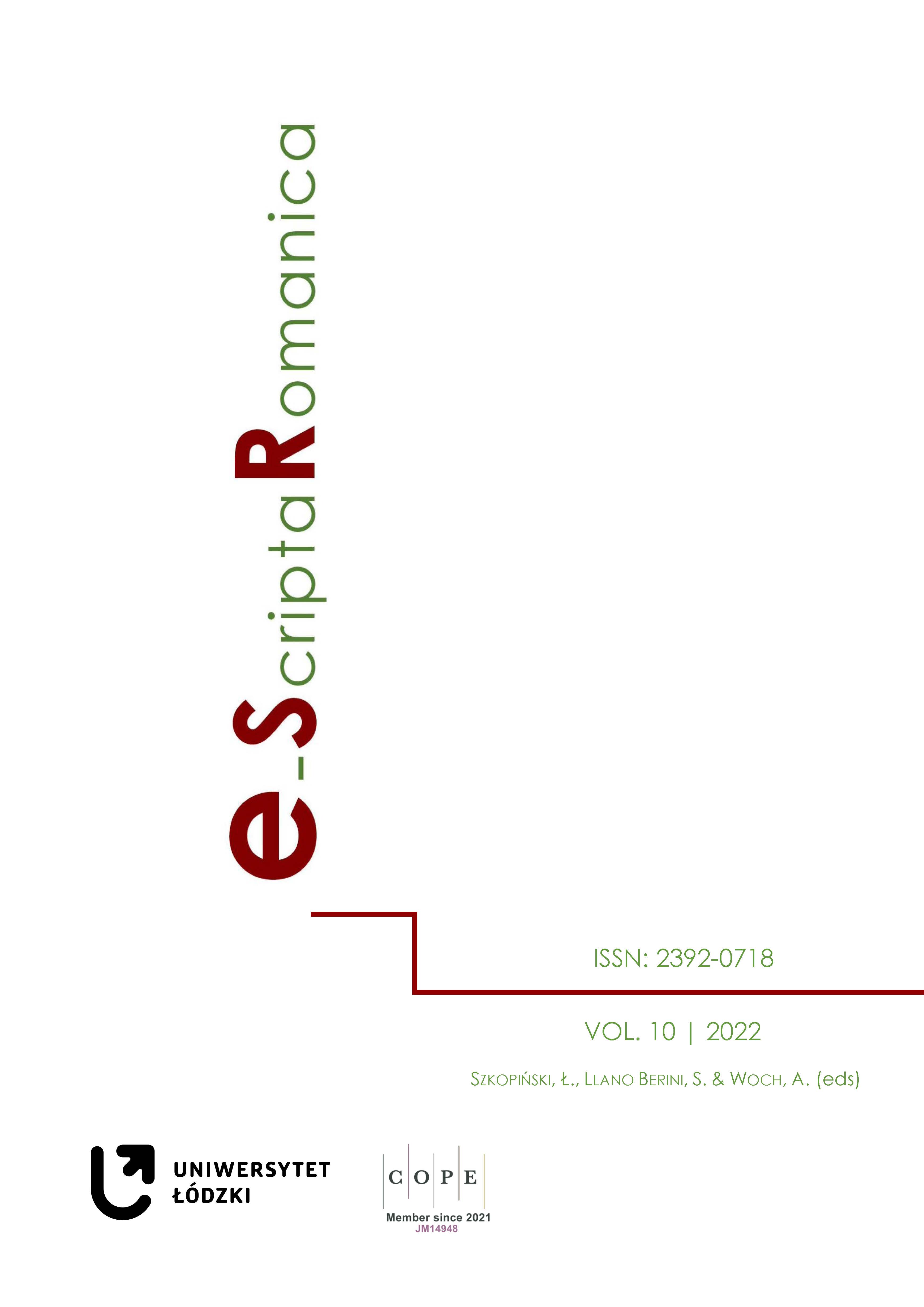Je devenais une goutte d’eau, une tache d’encre. Sulla narrativa di Maurice Blanchot
DOI:
https://doi.org/10.18778/2392-0718.10.07Palabras clave:
Maurice Blanchot, Philippe Hamon, Descriptif, fenomenologia, natura mortaResumen
Partendo da una serie di analisi contenute nell’opera di Philippe Hamon Rencontres sur tables et choses qui traînent. De la nature morte en littérature, questo saggio punta a sviluppare alcune considerazioni aventi per oggetto la produzione narrativa di Maurice Blanchot. In particolare le nostre osservazioni si concentreranno su alcuni passaggi desunti da tre romanzi del pensatore francese: Aminadab, La folie du jour e Le Très-Haut. In tal modo potremo mettere a punto una prospettiva interpretativa dei récits blanchotiani in cui la nozione di natura morta gioca un ruolo di assoluta centralità. In particolare le nostre analisi si concentreranno sul modo in cui la nozione di natura morta riesce a tramutarsi in un terminale ermeneutico trasversale in seno al quale numerosi elementi specifici e ricorrenti degli universi narrativi di Blanchot trovano una precisa collocazione funzionale e una chiara delineazione concettuale. In seconda battuta, le corrispondenze enucleabili tra il narratore francese e il teorico del descrittivo ci permetteranno di portare in evidenza in sede di conclusioni un ricco plesso di temi e questioni che non solo solcano in profondità la narrativa blanchotiana, ma di fatto possono essere reperiti con una certa facilità presso numerosi autori della letteratura francese del secondo Novecento.
Citas
AZOULAY, D. (2021). Aminadab. Art du roman, art de la mémoire. Roman 20-50. Maurice Blanchot. Thomas l’Obscur, Aminadab, Le Très-Haut, 70, pp. 121-133.
Google Scholar
DOI: https://doi.org/10.3917/r2050.070.0121
BLANCHOT, M. (1942). Aminadab. Paris : Gallimard.
Google Scholar
BLANCHOT, M. (1943). Faux pas. Paris : Gallimard.
Google Scholar
BLANCHOT, M. (1948). Le Très-Haut. Paris : Gallimard.
Google Scholar
BLANCHOT, M. (1949). La part du feu. Paris : Gallimard.
Google Scholar
BLANCHOT, M. (1955). L’espace littéraire. Paris : Gallimard.
Google Scholar
BLANCHOT, M. (1959). Le livre à venir. Paris : Gallimard.
Google Scholar
BLANCHOT, M. (1973). Le Pas au-delà. Paris : Gallimard.
Google Scholar
BLANCHOT, M. (1980). L’écriture du désastre. Paris : Gallimard.
Google Scholar
BLANCHOT, M. (1999). Henri Michaux ou le refus de l’enfermement. Tours : Farrago.
Google Scholar
BLANCHOT, M. (2002). La folie du jour. Paris : Gallimard.
Google Scholar
COLLIN, F. (1966). L’un et l’autre. Critique. Maurice Blanchot, 229, pp. 561-570.
Google Scholar
COOLS, A. (2010). Intentionnalité et singularité. Maurice Blanchot et la phénoménologie. In HOPPENOT, É. & MILON, A., Maurice Blanchot et la philosophie, Paris : Presses Universitaires de Paris Ouest, pp. 112-126.
Google Scholar
DOI: https://doi.org/10.4000/books.pupo.1112
COURTOIS, J.-P. (2003). La grammaticalisation de la fiction chez Maurice Blanchot. In BIDENT, CH. & VILAR, P., Blanchot. Récits critiques, Tours : Farrago, pp. 547-572.
Google Scholar
CRIVELLA, G. (2015). Animalisation e retentissement. Bachelard tra Blanchot e Artaud, in Association Internationale Gaston Bachelard. https://gastonbachelard.org/animalisation-e-retentissement-bachelard-tra-blanchot-e-artaud/ [26/03/2022].
Google Scholar
CRIVELLA, G. (2019). Autour de cette pierre le temps bouillonne. La questione del tempo in Maurice Blanchot. Logoi. Journal of Philosophy. TEMPORA, V (14), pp. 403-420.
Google Scholar
CRIVELLA, G. (2021). Vers « le lointain indisponible de l’image ». Sartre et Blanchot : une lecture croisée à partir de la notion d’imaginaire. Roman 20-50. Maurice Blanchot. Thomas l’Obscur, Aminadab, Le Très-Haut, 70, pp. 57-74.
Google Scholar
DOI: https://doi.org/10.3917/r2050.070.0057
DEGENEVE, J. (2007). Ce qui vient après la fin. Les reprises dans les épilogues du premier Blanchot. Europe. Revue littéraire mensuelle. Maurice Blanchot, 940-941, pp. 114-126.
Google Scholar
DE GRAMONT, J. (2011). Blanchot et la phénoménologie. L’effacement, l’événement. Paris : De Corlevour.
Google Scholar
DERRIDA, J. (1988). Parages. Paris : Galilée.
Google Scholar
DIDI-HUBERMAN, G. (2003). De ressemblance à ressemblance. In BIDENT, CH. & VILAR, P., Blanchot. Récits critiques, Paris : Farrago, pp. 143-169.
Google Scholar
FOUCAULT, M. (1966). La pensée du dehors. Critique. Maurice Blanchot, 229, pp. 523-546.
Google Scholar
FRIES, P. (1999). La théorie fictive de Maurice Blanchot. Paris : L’Harmattan.
Google Scholar
GENETTE, G. (2002). Figures V, Paris : Seuil.
Google Scholar
GROSSMAN, É. (2007). Les anagrammes de Blanchot. Europe. Revue littéraire mensuelle, 940-941, Maurice Blanchot, Août-Septembre, pp. 61-73.
Google Scholar
HAMON, P. (1981). Du descriptif. Paris : Hachette.
Google Scholar
HAMON, P. (2009). Imageries, littérature et image au XIXe siècle. Paris : José Corti.
Google Scholar
HAMON, P. (2019). Rencontres sur table et choses qui traînent. De la nature morte en littérature. Paris : Droz.
Google Scholar
LANNOY, J. L. (2011). Langage, perception, mouvement. Blanchot et Merleau-Ponty, Paris : Jérôme Millon.
Google Scholar
LAPORTE, R. (1966). Le oui, le non, le neutre. Critique. Maurice Blanchot, 229, pp. 579-590.
Google Scholar
LAPORTE, R. (1987). L’ancien, l’effroyablement ancien. Frontfroid Le Haut : Fata Morgana.
Google Scholar
LEVESQUE-JALBERT, É. (2021), « Entre centre et absence ». La chambre dans les romans de Blanchot. Roman 20-50. Maurice Blanchot. Thomas l’Obscur, Aminadab, Le Très-Haut, 70, pp. 29-40.
Google Scholar
DOI: https://doi.org/10.3917/r2050.070.0029
LEVINAS, E. (1966). La servante et son maître (à propos de L’attente l’oubli). Critique. Maurice Blanchot, 229, Paris : Minuit, pp. 514-522.
Google Scholar
LILTI, A. (2007). L’image du mort-vivant chez Blanchot et Kafka. Europe. Revue littéraire mensuelle. Maurice Blanchot, 940-941, pp. 154-166.
Google Scholar
MILON, A. (2015). Blanchot et Merleau-Ponty. Autour de l’(im)possible nomination. Revue de Métaphysoque et de Moral. Blanchot. Écriture et philosophie, 2, pp. 179-190.
Google Scholar
DOI: https://doi.org/10.3917/rmm.152.0179
MIRAUX, J.-P. (1998). Maurice Blanchot. Quiétude et inquiétude de la littérature. Paris : Nathan.
Google Scholar
POULET, G. (1966). Maurice Blanchot, critique et romancier. Critique, Maurice Blanchot, 229, pp. 485-497.
Google Scholar
ROPARS-WUILLEUMIER, M.-C. (1981). Le texte divisé. Essai sur l’écriture filmique. Paris : PUF.
Google Scholar
SARTRE, J.-P. (1984). « Aminadab » ou du fantastique considéré comme un langage. In SARTRE, J.-P., Situations. Essais critiques, vol. 1, Paris : Gallimard, pp. 115-126.
Google Scholar
STAROBINSKI, J. (1966). Thomas l’Obscur, chapitre premier. Critique, Maurice Blanchot, 229, pp. 498-513.
Google Scholar
Descargas
Publicado
Cómo citar
Número
Sección
Licencia

Esta obra está bajo una licencia internacional Creative Commons Atribución-NoComercial-SinDerivadas 4.0.











